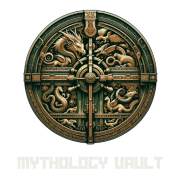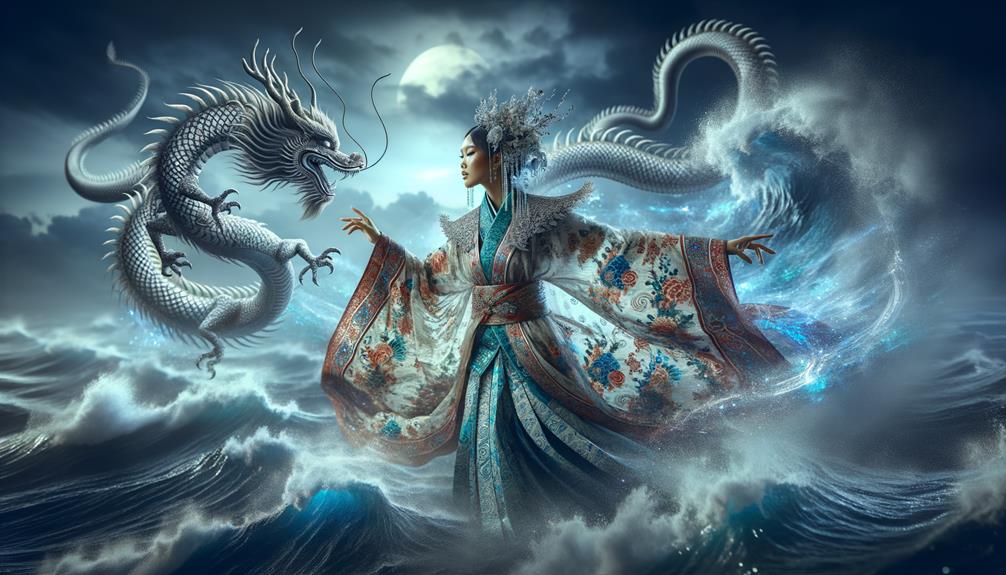Toyotamahime, the Dragon Princess from Japanese mythology, is an intriguing figure tying together the mortal and divine realms. Her story revolves around beauty, power, and transforming into a dragon after childbirth – an allegorical journey reflecting the human connection with the sacred. Like an epic protagonist overcoming obstacles, Toyotamahime represents duality, her narrative echoing through time. Analyzing her legacy and symbolic representations reveals insights into how we perceive identity and personal growth amidst our modern cultural landscape.
Historical Background
In Japan's ancient folklore, the legend of Toyotama-hime, the Dragon Princess, intertwines deities and humans. As the daughter of Ryujin, the mighty sea god, her birthright held divine might and intrigue. Her saga blends heroic motifs with the union between Toyotama-hime and the mortal hunter Hoori.
When Toyotama-hime and Hoori joined, their love transcended the divine and mortal realms. Giving birth to their son, destined to become Emperor Jimmu's ancestor, melded celestial and earthly lineages, marking a new era for Japan's imperial dynasty.
Toyotama-hime's post-childbirth transformation, often depicted as becoming a dragon, accentuated her otherworldly essence. This metamorphosis epitomized the enduring human-sea connection. Woven with beauty, divine heritage, and the intricate bond between mortals and gods, her story anchors Japan's imperial ancestry in the ocean's depths.
Mythological Significance
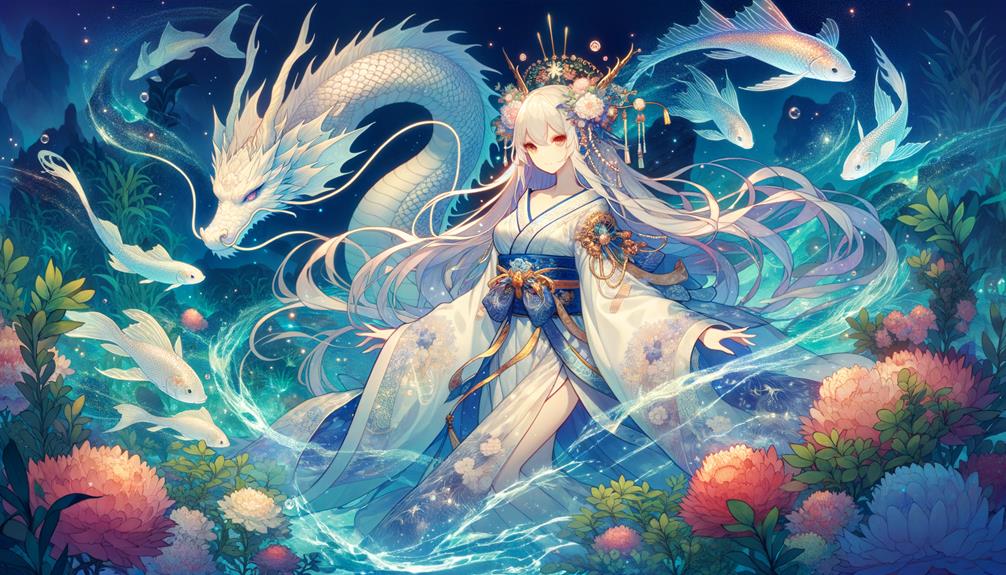
Toyotamahime's story symbolizes the deep ancestral connection between humans and the divine realms. Her journey represents transformation, blurring the lines between mortal and sacred origins. Toyotamahime embodies the timeless themes of beauty, metamorphosis, and the profound bond linking nature and humanity. Through her narrative, we glimpse the enduring cultural identity rooted in the sea's influence on Japan's imperial lineage.
Ancestral Lineage Importance
As the daughter of the sea god Ryujin, Toyotama-hime's royal blood courses through Japan's imperial roots, marking the start of a dynasty with profound cultural significance. Her marriage to Hoori, a descendant of the sun goddess Amaterasu, produced Ugayafukiaezu, whose lineage stretches directly to Emperor Jimmu, Japan's first emperor. This celestial connection highlights the sacred and mythological foundations of the imperial family and their ancient ancestry.
In Japan's origin legends, Toyotama-hime embodies the archetypal divine mother, bridging the realms of sea and heavens. Her story validates the divine right of Japanese rulers. Ryujin's influence flows through her bloodline, reinforcing the spiritual and legendary basis of Japanese sovereignty.
Through her son, Toyotama-hime's impact transcends her lifetime, shaping the core of Japan's imperial lineage. Her ancestry symbolizes the divine connection that legitimizes the emperor's reign, rooted in the sacred, mythological past. This celestial heritage remains integral to Japan's cultural and historical identity.
Cultural Symbolism Explained
Toyotama-hime, the Dragon Princess, intertwines mortal and divine realms in Japanese mythology. Her dual nature as woman and dragon symbolizes the beauty and power of the sea's mysterious depths. More than a shape-shifter, her story warns against breaking promises – when her husband Hoori betrays his vow, dire consequences follow.
This breach of trust emphasizes the sacredness of oaths in Japanese folklore. Toyotama-hime's tale, steeped in archetypal imagery, reflects the fragile relationship between humans and the divine. Her legend continues inspiring artistic explorations into the ocean's enigmatic allure while reminding us to respect boundaries.
Transformation Legend
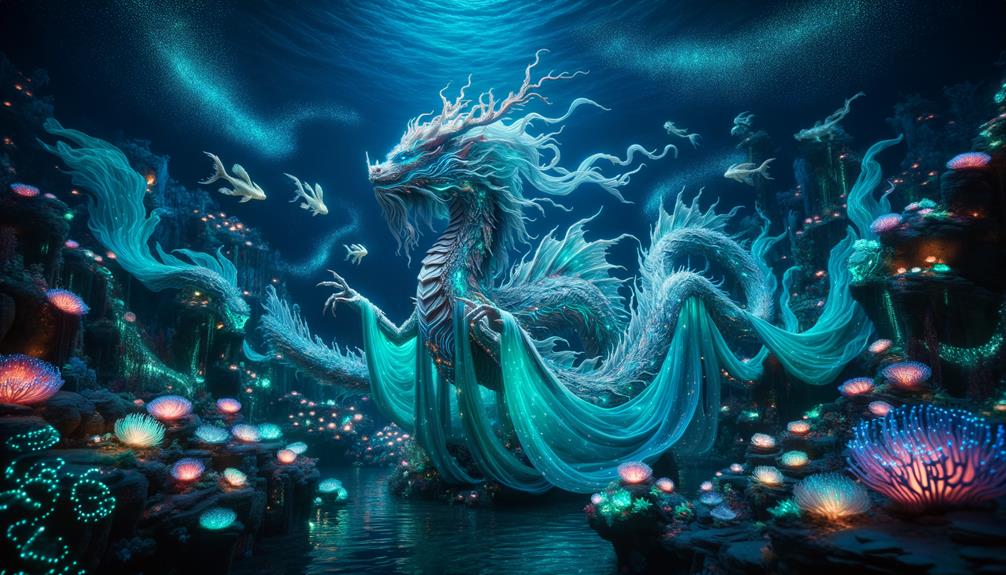
The legend of Toyotama-hime, the Dragon Princess, weaves an intriguing tale. Her transformation into a dragon after giving birth unveils her divine ancestry and intrinsic ties to the ocean's mystical depths. This metamorphosis transcends a mere change of form, embodying the profound power coursing through her veins and bridging the realms of humanity and the sea's enigmatic expanse. The dragon imagery serves as a symbolic archetype, representing hidden identities and the transformative nature inherent within her lineage.
Mythical Ancestry Origins
Toyotama-hime's story captivates with its intertwining of the divine and mortal realms. Born to Ryujin, the mighty Dragon King ruling the seas, she transformed into a dragon after childbirth, a powerful symbol linking celestial origins to human ancestry. Her marriage to Hoori led to a son who eventually fathered Emperor Jimmu, forging an imperial lineage rooted in mythical legacy.
The tale transcends mere folklore, establishing profound connections between Japanese mythology and history. Toyotama-hime's transcendence bridges the realms of gods and humans, her metamorphosis a reminder of the ancient forces shaping our world. Through archetypal symbols and epic narratives, her story endures, a timeless tapestry woven from the threads of divinity and mortality.
Symbolic Dragon Imagery
Toyotamahime's legend paints her dragon transformation after giving birth as a striking metaphor, melding divine power and human vulnerability. At that pivotal moment, her shift from sea deity into a wani, or dragon, captured the essence of her dual nature. This imagery goes beyond symbolizing might and beauty – it's a profound exploration of metamorphosis and the complexities of identity.
The dragon motif woven throughout reflects Toyotamahime's mystical qualities and bond with the ocean. As a deity, her ability to transform signifies mastery over the natural world and its elements, a theme that resonates through her journey of self-discovery.
| Aspect | Interpretation |
|---|---|
| Dragon Form | Her divinity and connection to the sea |
| Transformation | Encompasses power, beauty, and mysticism |
| Hidden Identities | Duality of the sacred and the human |
Through this metamorphosis after childbirth, Toyotamahime personifies the quintessential story of unearthing one's authentic self. The profound changes mark a convergence of the celestial and terrestrial realms central to her existence. Decoding this symbolic dragon imagery unveils deeper layers within Toyotamahime's tale, where transformation emerges as both a revelation and an affirmation of her extraordinary essence.
Cultural Depictions
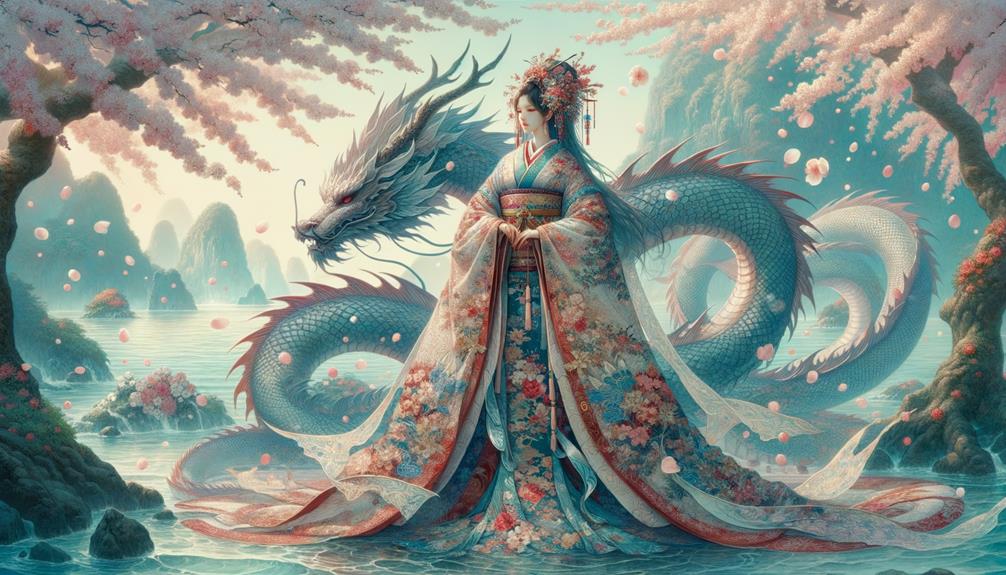
Toyotama-hime, the Dragon Princess, interweaves deeply into Japanese culture's tapestry through numerous stories and artistic expressions. As the sea god's beautiful daughter, her mythic journey explores love and transformation. She married the mortal hunter Hoori, who ventured into her underwater realm. Their union symbolized a bridge between the divine and human worlds.
Artists frequently depict Toyotama-hime in her true majestic dragon form, embodying the ocean's power and enigma. Her narrative explores archetypal themes like love, betrayal, and metamorphosis, resonating profoundly within the human psyche.
Traditional Japanese paintings and woodblock prints capture her dual nature's beauty and mystique. Kabuki and Noh theatrical performances dramatize her tragic love story and celestial origins. Folktales and poems immortalize her as a symbol of the ocean's allure and fleeting happiness.
Toyotama-hime's enduring presence across cultural depictions reminds us of the timeless connection between humanity and the divine realms.
Modern Interpretations
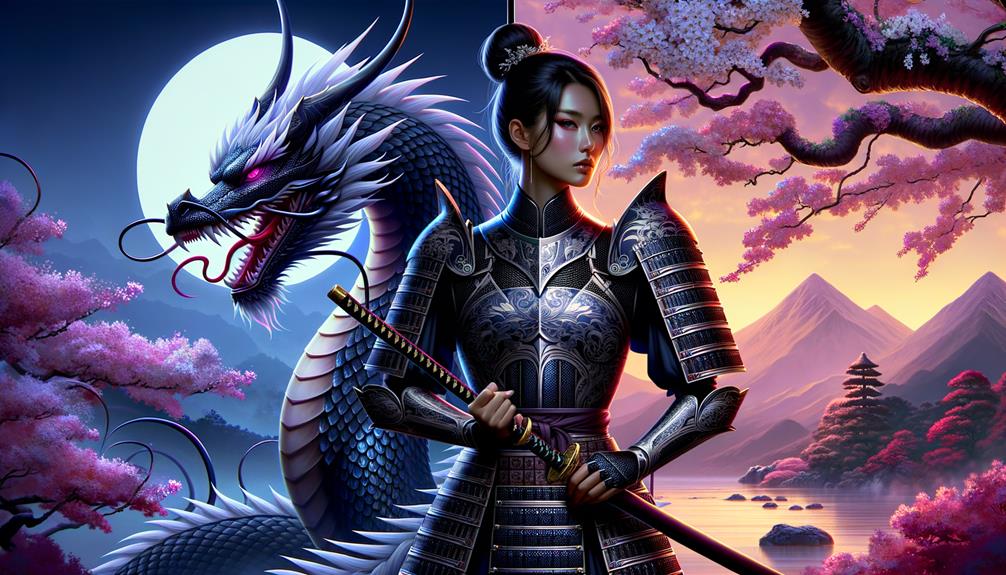
Toyotama-hime's mythological essence infuses modern narratives with enduring power, inspiring works across various mediums. Her archetypal story manifests in Japanese media through human-dragon hybrid characters, echoing her transformation between humanity and nature's primal forces.
In Samantha Shannon's 'The Priory of the Orange Tree,' Toyotama-hime's legend subtly interweaves with themes of love, loss, and metamorphosis. The extinct crocodile genus 'Toyotamaphimeia' immortalizes her name, bridging myth and scientific reality.
Toyotama-hime embodies the ocean's duality – both beautiful and perilous. This dichotomy resonates profoundly in contemporary literature and entertainment. Her tale's emotional depth and timeless themes inspire creators, ensuring her legacy transcends generations. Through these modern interpretations, Toyotama-hime's mysteries continue to captivate audiences.
Lasting Influence
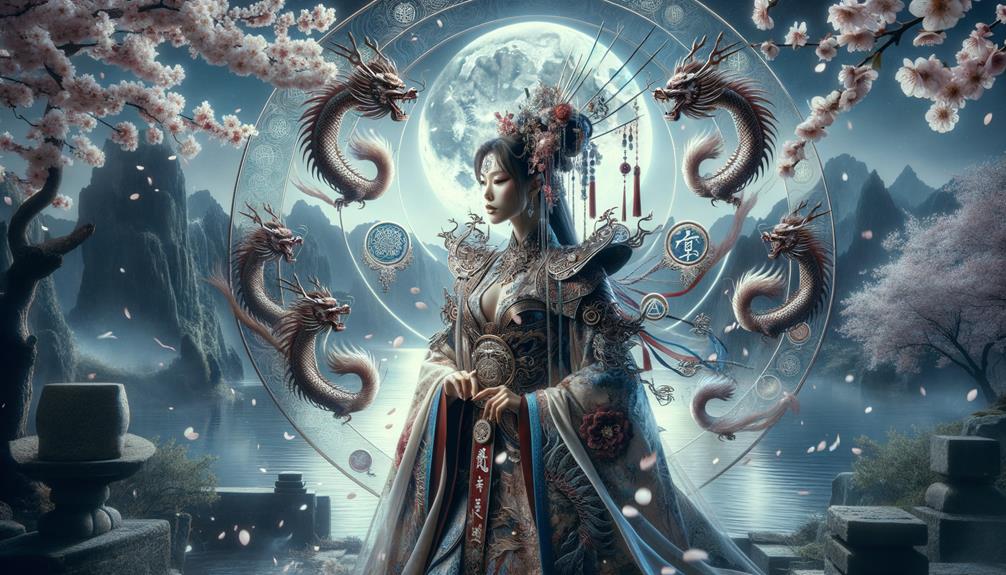
Toyotama-hime's ancient legend spans generations, embodying the duality of human and dragon identities. Her transformative tale captures imaginations through multifaceted portrayals across media.
Literature echoes Toyotama-hime's impact, as novels like 'The Priory of the Orange Tree' creatively weave elements from her myth. Her story's enduring resonance manifests in science too, influencing names like the extinct crocodile genus 'Toyotamaphimeia.'
Anime and video games frequently depict human-dragon hybrids, mirroring Toyotama-hime's essence. These representations symbolize the harmony and tension between contrasting identities, reflecting the timeless allure of her transformative narrative.
Toyotama-hime's legacy lives on, a testament to mythology's profound influence on art, culture, and human connection across mediums.
Frequently Asked Questions
What Is Toyotama Hime the Goddess Of?
As the ocean deity and ruler of serpentine beings, Toyotama Hime represents the depths' enigmas and sublime charm. Her bloodline birthed emperors, weaving human and mystical realms into an epic saga. No mortal could resist her allure as she gracefully emerged from the waves, captivating all with her ethereal presence. Even today, she remains an enduring symbol of nature's untamed power and incomparable beauty.
What Happened When Hiko Hoho Demi No Mikoto Secretly Spied on Toyo Tama Hime While She Was in Childbirth?
When I secretly observed Toyotama-hime during childbirth, she transformed into a magnificent dragon, revealing her divine origins. My actions betrayed a sacred trust, highlighting the severe repercussions of overstepping boundaries between the mortal and divine realms.
Does Hime Mean Princess in Japanese?
'Hime' literally translates to 'princess' in Japanese, referring to someone of royal or noble status. Interestingly, Japanese mythology contains over 200 tales featuring 'Hime' characters, representing the sacred feminine and authority. This title encapsulates grace alongside power.
Who Is the Most Famous Japanese Princess?
When it comes to legendary Japanese princesses, Toyotama-hime stands out. Tales depict her as a striking figure intertwined with the majesty of the ocean's depths. Her mythical journey bridges the mortal and divine realms, captivating audiences through the ages.
